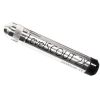Seametrics BaroSCOUT 2X Barometric Pressure Loggers
Features
- Increased memory to 100,000 records
- Integrated SDI-12 or Modbus RTU RS485 output
- 4.5-year battery life with user-replaceable batteries
- Free ground shipping
- Expedited repair and warranty service
- Lifetime technical support
- More
Overview
The Seametrics BaroSCOUT 2X Smart Sensor is designed to measure barometric pressure, along with temperature. It is an ideal companion to the LevelSCOUT 2X absolute pressure/level sensors and can be used to adjust their readings for atmospheric pressure.
Design
This industry-standard digital RS485 interface device records up to 100,000 records of pressure, temperature, and time data and operates with low power. The Seametrics BaroSCOUT 2X Smart Sensor and features easy-to-use Aqua4Plus 2.0 software with powerful features. Constructed with 316 stainless steel, acetal, and Viton, this sensor provides high-accuracy readings in rugged and corrosive field conditions.
The BaroSCOUT 2X utilizes an extremely rugged and stable piezo-electric media-isolated pressure element combined with a 16-bit analog-to-digital converter. This provides extremely accurate and stable pressure input into the microprocessor on the circuit board that measures the pressure and stores the data in non-volatile memory.
Power
A replaceable 2/3 AA 3.6v lithium battery powers the BaroSCOUT 2X. The unit is programmed using our easy-to-use control software. Once programmed the unit will measure and collect data at the time interval programmed.
*Note: The BaroSCOUT 2X is intended for use in the atmosphere—not to be submerged.
In The News
Floating Global New Ideas: Buoy-Enabled Research at Florida Agricultural and Mechanical University’s School of the Environment
Florida Agricultural and Mechanical University (FAMU), based in Tallahassee, Florida, is the highest-rated public Historically Black College or University in the United States. FAMU’s School of the Environment (FAMU-SOE) offers BS and BA degrees in Environmental Studies, and BS, MS, and Ph.D. degrees in Environmental Science, with specialisms available in areas including Environmental Policy and Risk Management, Aquatic and Terrestrial Ecology, and Biomolecular Sciences. In 2021, FAMU-SOE deployed a NexSens CB-450 buoy in Apalachee Bay, a key oyster farming area around 30 miles south of Tallahassee. The buoy has quickly been incorporated into the curriculum, providing environmental insights for student research, the community, and beyond. Dr.
Read MoreMonitoring Habitat Suitability and Water Quality in Northwest Arkansas Springs
Northwest Arkansas has seen an economic, industrial, and population boom in recent years as a result of expanding businesses, which have created thousands of jobs in the region and the mass migration of employees and construction companies. However, with this growth has come rapid urbanization and the degradation of the natural landscape, specifically the freshwater springs that can be found throughout the region. These springs are critical habitat centers for native wildlife, home to threatened and endangered fish, and those that have yet to be listed. Zach Moran, Assistant Professor of Fisheries Science at Arkansas Technical University, is working to help monitor these habitats and provide key data that will hopefully inform future development in the region.
Read MoreThree Decades of Research at Acton Lake
A multi-disciplinary team at Miami University, Ohio, has been studying the environmental change at Acton Lake for over three decades. Using three different NexSens buoys over this time, the team has an incredible archive of data that is helping build a picture of Acton’s past, present, and future. Until recently, a NexSens CB-50 buoy was used alongside other environmental monitoring at Acton Lake. In May 2025, the Miami team deployed a new XB-200 buoy , future-proofing their ongoing monitoring using real-time buoy systems. Acton Lake, a small hypereutrophic reservoir in southwest Ohio, covers 2.4km² and has a maximum depth of about 8m. The dam was built in 1956, and the lake has a large agricultural watershed.
Read More












